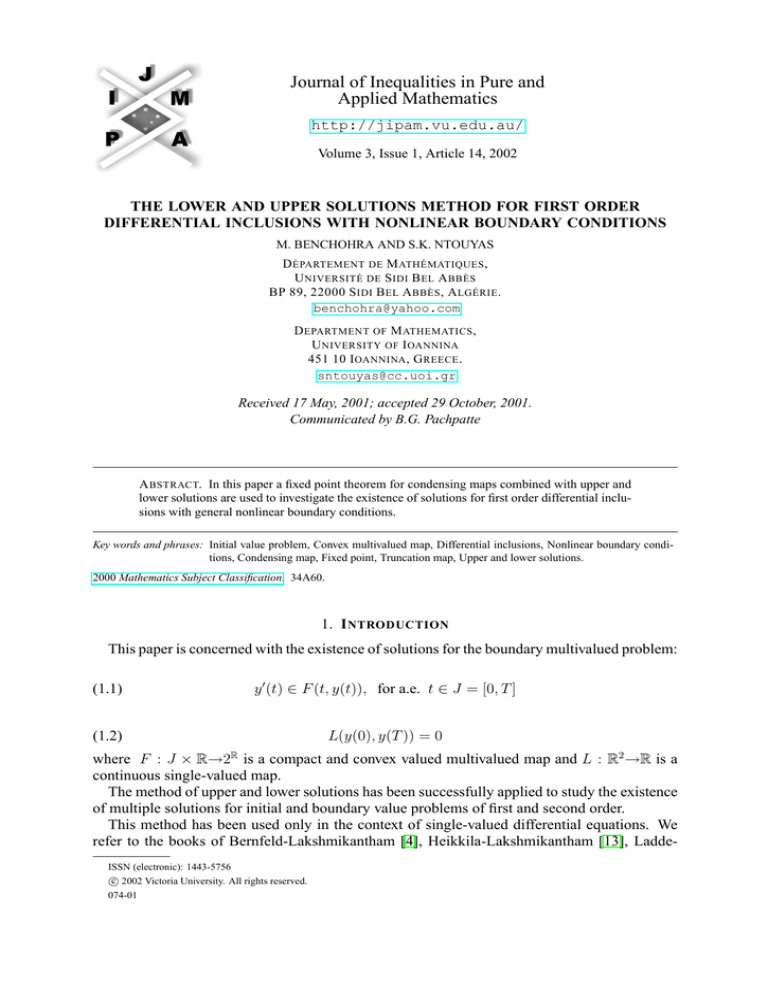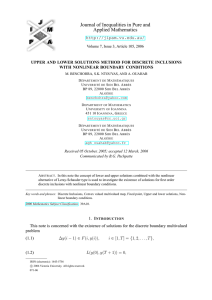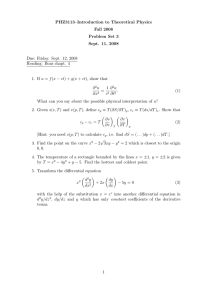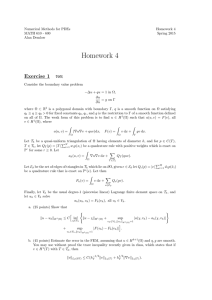
Journal of Inequalities in Pure and
Applied Mathematics
http://jipam.vu.edu.au/
Volume 3, Issue 1, Article 14, 2002
THE LOWER AND UPPER SOLUTIONS METHOD FOR FIRST ORDER
DIFFERENTIAL INCLUSIONS WITH NONLINEAR BOUNDARY CONDITIONS
M. BENCHOHRA AND S.K. NTOUYAS
D ÉPARTEMENT DE M ATHÉMATIQUES ,
U NIVERSITÉ DE S IDI B EL A BBÈS
BP 89, 22000 S IDI B EL A BBÈS , A LGÉRIE .
benchohra@yahoo.com
D EPARTMENT OF M ATHEMATICS ,
U NIVERSITY OF I OANNINA
451 10 I OANNINA , G REECE .
sntouyas@cc.uoi.gr
Received 17 May, 2001; accepted 29 October, 2001.
Communicated by B.G. Pachpatte
A BSTRACT. In this paper a fixed point theorem for condensing maps combined with upper and
lower solutions are used to investigate the existence of solutions for first order differential inclusions with general nonlinear boundary conditions.
Key words and phrases: Initial value problem, Convex multivalued map, Differential inclusions, Nonlinear boundary conditions, Condensing map, Fixed point, Truncation map, Upper and lower solutions.
2000 Mathematics Subject Classification. 34A60.
1. I NTRODUCTION
This paper is concerned with the existence of solutions for the boundary multivalued problem:
(1.1)
y 0 (t) ∈ F (t, y(t)), for a.e. t ∈ J = [0, T ]
(1.2)
L(y(0), y(T )) = 0
where F : J × R→2R is a compact and convex valued multivalued map and L : R2 →R is a
continuous single-valued map.
The method of upper and lower solutions has been successfully applied to study the existence
of multiple solutions for initial and boundary value problems of first and second order.
This method has been used only in the context of single-valued differential equations. We
refer to the books of Bernfeld-Lakshmikantham [4], Heikkila-Lakshmikantham [13], LaddeISSN (electronic): 1443-5756
c 2002 Victoria University. All rights reserved.
074-01
2
M. B ENCHOHRA AND S.K. N TOUYAS
Lakshmikantham-Vatsala [16], to the thesis of De Coster [7], to the papers of Carl-HeikkilaKumpulainen [6], Cabada [5], Frigon [9], Frigon-O’Regan [10], Heikkila-Cabada [12],
Lakshmikantham-Leela [17], Nkashama [20] and the references therein.
Using this method the authors obtained in [2] and [3] existence results for differential inclusions with periodic boundary conditions, for first and second order respectively.
In this paper we establish an existence result for the problem (1.1) – (1.2). Our approach is
based on the existence of upper and lower solutions and on a fixed point theorem for condensing
maps due to Martelli [19].
2. P RELIMINARIES
We will briefly recall some basic definitions and facts from multivalued analysis that we will
use in the sequel.
AC(J, R) is the space of all absolutely continuous functions y : J→R.
Condition
y ≤ ȳ if and only if y(t) ≤ ȳ(t) for all t ∈ J
defines a partial ordering in AC(J, R). If α, β ∈ AC(J, R) and α ≤ β, we denote
[α, β] = {y ∈ AC(J, R) : α ≤ y ≤ β}.
W 1,1 (J, R) denotes the Banach space of functions y : J→R which are absolutely continuous
and whose derivative y 0 (which exists almost everywhere) is an element of L1 (J, R) with the
norm
kykW 1,1 = kykL1 + ky 0 kL1 for all y ∈ W 1,1 (J, R).
Let (X, |·|) be a normed space. A multivalued map G : X→2X is convex (closed) valued if
G(x) is convex (closed) for all x ∈ X. G is bounded on bounded sets if G(B) = ∪x∈B G(x) is
bounded in X for all bounded subsets B of X (i.e. supx∈B {sup{|y| : y ∈ G(x)}} < ∞). G
is called upper semi-continuous (u.s.c.) on X if for each x0 ∈ X the set G(x0 ) is a nonempty,
closed subset of X, and if for each open set V of X containing G(x0 ), there exists an open
neighbourhood U of x0 such that G(U ) ⊆ V.
G is said to be completely continuous if G(B) is relatively compact for every bounded subset
B ⊂ X.
If the multivalued map G is completely continuous with nonempty compact values, then G is
u.s.c. if and only if G has a closed graph (i.e. xn →x∗ , yn →y∗ , yn ∈ G(xn ) imply y∗ ∈ G(x∗ )).
G has a fixed point if there is x ∈ X such that x ∈ G(x).
In the following CC(X) denotes the set of all nonempty compact and convex subsets of X.
An upper semi-continuous map G : X→2X is said to be condensing [19] if for any bounded
subset B ⊆ X, with µ(B) 6= 0, we have µ(G(B)) < µ(B), where µ denotes the Kuratowski
measure of noncompacteness [1]. We remark that a compact map is the easiest example of a
condensing map. For more details on multivalued maps see the books of Deimling [8] and Hu
and Papageorgiou [15].
The multivalued map F : J→CC(R) is said to be measurable, if for every y ∈ R, the
function t 7−→ d(y, F (t)) = inf{|y − z| : z ∈ F (t)} is measurable.
Definition 2.1. A multivalued map F : J × R→2R is said to be an L1 -Carathéodory if
(i) t 7−→ F (t, y) is measurable for each y ∈ R;
(ii) y 7−→ F (t, y) is upper semicontinuous for almost all t ∈ J;
(iii) For each k > 0 , there exists hk ∈ L1 (J, R+ ) such that
kF (t, y)k = sup{|v| : v ∈ F (t, y)} ≤ hk (t) for all |y| ≤ k and for almost all t ∈ J.
So let us start by defining what we mean by a solution of problem (1.1) – (1.2).
J. Inequal. Pure and Appl. Math., 3(1) Art. 14, 2002
http://jipam.vu.edu.au/
F IRST O RDER D IFFERENTIAL I NCLUSIONS
3
Definition 2.2. A function y ∈ AC(J, R) is said to be a solution of (1.1) – (1.2) if there exists
a function v ∈ L1 (J, R) such that v(t) ∈ F (t, y(t)) a.e. on J, y 0 (t) = v(t) a.e. on J and
L(y(0), y(T )) = 0.
The following concept of lower and upper solutions for (1.1) – (1.2) has been introduced by
Halidias and Papageorgiou in [14] for second order multivalued boundary value problems. It
will be the basic tools in the approach that follows.
Definition 2.3. A function α ∈ AC(J, R) is said to be a lower solution of (1.1) – (1.2) if there
exists v1 ∈ L1 (J, R) such that v1 (t) ∈ F (t, α(t)) a.e. on J, α0 (t) ≤ v1 (t) a.e. on J and
L(α(0), α(T )) ≤ 0.
Similarly, a function β ∈ AC(J, R) is said to be an upper solution of (1.1) – (1.2) if there
exists v2 ∈ L1 (J, R) such that v2 (t) ∈ F (t, β(t)) a.e. on J, β 0 (t) ≥ v2 (t) a.e. on J and
L(β(0), β(T )) ≥ 0.
1
For the multivalued map F and for each y ∈ C(J, R) we define SF,y
by
1
SF,y
= {v ∈ L1 (J, R) : v(t) ∈ F (t, y(t)) for a.e. t ∈ J}.
Our main result is based on the following:
Lemma 2.1. [18]. Let I be a compact real interval and X be a Banach space. Let F : I ×
X→CC(X); (t, y) → F (t, y) measurable with respect to t for any y ∈ X and u.s.c. with
1
respect to y for almost each t ∈ I and SF,y
6= ∅ for any y ∈ C(I, X) and let Γ be a linear
1
continuous mapping from L (I, X) to C(I, X), then the operator
1
Γ ◦ SF1 : C(I, X)→CC(C(I, X)), y 7−→ (Γ ◦ SF1 )(y) := Γ(SF,y
)
is a closed graph operator in C(I, X) × C(I, X).
Lemma 2.2. [19]. Let G : X→CC(X) be an u.s.c. condensing map. If the set
M := {v ∈ X : λv ∈ G(v) for some λ > 1}
is bounded, then G has a fixed point.
3. M AIN R ESULT
We are now in a position to state and prove our existence result for the problem (1.1) – (1.2).
Theorem 3.1. Suppose F : J × R→CC(R) is an L1 -Carathéodory multivalued map. In
addition assume the following conditions
(H1) there exist α and β in W 1,1 (J, R) lower and upper solutions respectively for the problem
(1.1) – (1.2) such that α ≤ β,
(H2) L is a continuous single-valued map in (x, y) ∈ [α(0), β(0)] × [α(T ), β(T )] and nonincreasing in y ∈ [α(T ), β(T )],
are satisfied. Then the problem (1.1) – (1.2) has at least one solution y ∈ W 1,1 (J, R) such
that
α(t) ≤ y(t) ≤ β(t) for all t ∈ J.
Proof. Transform the problem into a fixed point problem. Consider the following modified
problem (see [5])
(3.1)
y 0 (t) + y(t) ∈ F1 (t, y(t)), a.e. t ∈ J,
(3.2)
y(0) = τ (0, y(0) − L(y(0), y(T )))
where F1 (t, y) = F (t, τ (t, y)) + τ (t, y),
τ (t, y(t)).
J. Inequal. Pure and Appl. Math., 3(1) Art. 14, 2002
τ (t, y) = max{α(t), min{y, β(t)}} and y(t) =
http://jipam.vu.edu.au/
4
M. B ENCHOHRA AND S.K. N TOUYAS
Remark 3.2.
(i) Notice that F1 is an L1 -Carathéodory multivalued map with compact convex values and there exists φ ∈ L1 (J, R+ ) such that
kF1 (t, y(t))k ≤ φ(t) + max(sup |α(t)|, sup |β(t)|) for a.e. t ∈ J and all y ∈ C(J, R).
t∈J
t∈J
(ii) By the definition of τ it is clear that α(0) ≤ y(0) ≤ β(0).
Clearly a solution to (3.1) – (3.2) is a fixed point of the operator N : C(J, R)→2C(J,R) defined
by
Z t
1
N (y) := h ∈ C(J, R) : h(t) = y(0) +
[v(s) + y(s) − y(s)]ds, v ∈ S̃F,y
0
where
1
1
S̃F,y
= {v ∈ SF,y
: v(t) ≥ v1 (t) a.e. on A1 and v(t) ≤ v2 (t) a.e. on A2 },
1
SF,y
= {v ∈ L1 (J, R) : v(t) ∈ F (t, y(t)) for a.e. t ∈ J},
A1 = {t ∈ J : y(t) < α(t) ≤ β(t)}, A2 = {t ∈ J : α(t) ≤ β(t) < y(t)}.
1
Remark 3.3.
(i) For each y ∈ C(J, R) the set SF,y
is nonempty (see Lasota and Opial
[18]).
1
1
(ii) For each y ∈ C(J, R) the set S̃F,y
is nonempty. Indeed, by (i) there exists v ∈ SF,y
. Set
w = v1 χA1 + v2 χA2 + vχA3 ,
where
A3 = {t ∈ J : α(t) ≤ y(t) ≤ β(t)}.
1
.
Then by decomposability w ∈ S̃F,y
We shall show that N is a completely continuous multivalued map, u.s.c. with convex closed
values. The proof will be given in several steps.
Step 1: N (y) is convex for each y ∈ C(J, R).
1
1
such that
and v ∈ S̃F,y
Indeed, if h, h belong to N (y), then there exist v ∈ S̃F,y
Z t
h(t) = y(0) +
[v(s) + y(s) − y(s)]ds, t ∈ J
0
and
Z
t
[v(s) + y(s) − y(s)]ds, t ∈ J.
h(t) = y(0) +
0
Let 0 ≤ k ≤ 1. Then for each t ∈ J we have
Z t
[kv(s) + (1 − k)v(s) + y(s) − y(s)]ds.
[kh + (1 − k)h](t) = y(0) +
0
1
Since S̃F,y
is convex (because F has convex values) then
kh + (1 − k)h ∈ G(y).
Step 2: N sends bounded sets into bounded sets in C(J, R).
Let Br := {y ∈ C(J, R) : kyk∞ ≤ r}, (kyk∞ := sup{|y(t)| : t ∈ J}) be a bounded set in
1
C(J, R) and y ∈ Br , then for each h ∈ N (y) there exists v ∈ S̃F,y
such that
Z t
h(t) = y(0) +
[v(s) + y(s) − y(s)]ds, t ∈ J.
0
J. Inequal. Pure and Appl. Math., 3(1) Art. 14, 2002
http://jipam.vu.edu.au/
F IRST O RDER D IFFERENTIAL I NCLUSIONS
5
Thus for each t ∈ J we get
Z
|h(t)| ≤ |y(0)| +
t
[|v(s)| + |y(s)| + |y(s)|]ds
0
≤ max(α(0), β(0)) + kφr kL1 + T max(r, sup |α(t)|, sup |β(t)|) + T r.
t∈J
t∈J
Step 3: N sends bounded sets in C(J, R) into equicontinuous sets.
Let u1 , u2 ∈ J, u1 < u2 , Br := {y ∈ C(J, R) : kyk∞ ≤ r} be a bounded set in C(J, R) and
1
y ∈ Br . For each h ∈ N (y) there exists v ∈ S̃F,y
such that
Z t
h(t) = y(0) +
[v(s) + y(s) − y(s)]ds, t ∈ J.
0
We then have
Z
u2
|h(u2 ) − h(u1 )| ≤
[|v(s) + y(s)| + |y(s)|]ds
Zu1u2
≤
|φr (s)|ds + (u2 − u1 ) max(r, sup |α(t)|, sup |β(t)|) + r(u2 − u1 ).
t∈J
u1
t∈J
As a consequence of Step 2, Step 3 together with the Ascoli-Arzela theorem we can conclude
that N : C(J, R)→2C(J,R) is a compact multivalued map, and therefore, a condensing map.
Step 4: N has a closed graph.
Let yn →y0 , hn ∈ N (yn ) and hn →h0 . We shall prove that h0 ∈ N (y0 ).
hn ∈ N (yn ) means that there exists vn ∈ S̃F,yn such that
Z t
hn (t) = y(0) +
[vn (s) + y n (s) − yn (s)]ds, t ∈ J.
0
1
We must prove that there exists v0 ∈ S̃F,y
such that
0
Z t
h0 (t) = y(0) +
[v0 (s) + y 0 (s) − y0 (s)]ds, t ∈ J.
0
Consider the linear continuous operator Γ : L1 (J, R)→C(J, R) defined by
Z t
(Γv)(t) =
v(s)ds.
0
We have
Z t
Z t
hn − y(0) −
→0.
[y
(s)
−
y
(s)]
ds
−
h
−
y(0)
+
[y
(s)
−
y
(s)]
ds
n
0
0
n
0
0
0
∞
S̃F1
From Lemma 2.1, it follows that Γ ◦
is a closed graph operator.
Also from the definition of Γ we have that
Z t
1
hn (t) − y(0) −
[y n (s) − y0 (s)] ds ∈ Γ S̃F,y
.
n
0
Since yn →y0 it follows from Lemma 2.1 that
Z t
h0 (t) = y(0) +
[v0 (s) + y 0 (s) − y0 (s)]ds, t ∈ J
0
1
S̃F,y
.
0
for some v0 ∈
Next we shall show that N has a fixed point, by proving that
J. Inequal. Pure and Appl. Math., 3(1) Art. 14, 2002
http://jipam.vu.edu.au/
6
M. B ENCHOHRA AND S.K. N TOUYAS
Step 5: The set
M := {v ∈ C(J, R) : λv ∈ N (v) for some λ > 1}
is bounded.
1
such that
Let y ∈ M then λy ∈ N (y) for some λ > 1. Thus there exists v ∈ S̃F,y
Z t
y(t) = λ−1 y(0) + λ−1
[v(s) + y(s) − y(s)]ds, t ∈ J.
0
Thus
t
Z
|v(s) + y(s) − y(s)|ds,
|y(t)| ≤ |y(0)| +
t ∈ J.
0
From the definition of τ there exists φ ∈ L1 (J, R+ ) such that
kF (t, y(t))k = sup{|v| : v ∈ F (t, y(t))} ≤ φ(t) for each y ∈ C(J, R),
Z t
|y(s)|ds.
|y(t)| ≤ max(α(0), β(0)) + kφkL1 + T max(sup |α(t)|, sup |β(t)|) +
t∈J
t∈J
0
Set
z0 = max(α(0), β(0)) + kφkL1 + T max(sup |α(t)|, sup |β(t)|).
t∈J
t∈J
Using the Gronwall’s Lemma ([11, p. 36]) we get for each t ∈ J
Z t
|y(t)| ≤ z0 + z0
et−s ds
0
≤ z0 + z0 (et − 1).
Thus
kyk∞ ≤ z0 + z0 (eT − 1).
This shows that M is bounded.
Hence, Lemma 2.2 applies and N has a fixed point which is a solution to problem (3.1) –
(3.2).
Step 6: We shall show that the solution y of (3.1)-(3.2) satisfies
α(t) ≤ y(t) ≤ β(t) for all t ∈ J.
Let y be a solution to (3.1) – (3.2). We prove that
α(t) ≤ y(t) for all t ∈ J.
Suppose not. Then there exist t1 , t2 ∈ J, t1 < t2 such that α(t1 ) = y(t1 ) and
α(t) > y(t) for all t ∈ (t1 , t2 ).
In view of the definition of τ one has
y 0 (t) + y(t) ∈ F (t, α(t)) + α(t) a.e. on
(t1 , t2 ).
Thus there exists v(t) ∈ F (t, α(t)) a.e. on J with v(t) ≥ v1 (t) a.e. on (t1 , t2 ) such that
y 0 (t) + y(t) = v(t) + α(t) a.e. on
(t1 , t2 ).
An integration on (t1 , t], with t ∈ (t1 , t2 ) yields
Z t
y(t) − y(t1 ) =
[v(s) + (α − y)(s)]ds
t1
t
Z
>
v(s)ds.
t1
J. Inequal. Pure and Appl. Math., 3(1) Art. 14, 2002
http://jipam.vu.edu.au/
F IRST O RDER D IFFERENTIAL I NCLUSIONS
7
Since α is a lower solution to (1.1) – (1.2), then
Z t
α(t) − α(t1 ) ≤
v1 (s)ds, t ∈ (t1 , t2 ).
t1
It follows from the facts y(t1 ) = α(t1 ), v(t) ≥ v1 (t) that
α(t) < y(t) for all t ∈ (t1 , t2 )
which is a contradiction, since y(t) < α(t) for all t ∈ (t1 , t2 ). Consequently
α(t) ≤ y(t) for all t ∈ J.
Analogously, we can prove that
y(t) ≤ β(t) for all t ∈ J.
This shows that the problem (3.1) – (3.2) has a solution in the interval [α, β].
Finally, we prove that every solution of (3.1) – (3.2) is also a solution to (1.1) – (1.2). We
only need to show that
α(0) ≤ y(0) − L(y(0), y(T )) ≤ β(0).
Notice first that we can prove that
α(T ) ≤ y(T ) ≤ β(T ).
Suppose now that y(0) − L(y(0), y(T )) < α(0). Then y(0) = α(0) and
y(0) − L(α(0), y(T )) < α(0).
Since L is nonincreasing in y, we have
α(0) ≤ α(0) − L(α(0), α(T )) ≤ α(0) − L(α(0), y(T )) < α(0)
which is a contradiction.
Analogously we can prove that
y(0) − L(τ (0), τ (T )) ≤ β(0).
Then y is a solution to (1.1) – (1.2).
Remark 3.4. Observe that if L(x, y) = ax − by − c, we obtain that Theorem 3.1 gives an
existence result for the problem
y 0 (t) ∈ F (t, y(t)), for a.e. t ∈ J = [0, T ]
ay(0) − by(T ) = c
with a, b ≥ 0, a + b > 0 which includes the periodic case (a = b = 1, c = 0) and the initial
and the terminal problem.
R EFERENCES
[1] J. BANAS AND K. GOEBEL, Measures of Noncompactness in Banach Spaces, Marcel Dekker,
New York, 1980.
[2] M. BENCHOHRA AND S. K. NTOUYAS, On first order differential inclusions with periodic
boundary conditions, preprint.
[3] M.BENCHOHRA AND S. K. NTOUYAS, On second order differential inclusions with periodic
boundary conditions, Acta Math. Univ. Comen., LXIX (2000), 173–181.
[4] S. BERNFELD AND V. LAKSHMIKANTHAM, An Introduction to Nonlinear Boundary Value
Problems, Academic Press, New York, 1974.
J. Inequal. Pure and Appl. Math., 3(1) Art. 14, 2002
http://jipam.vu.edu.au/
8
M. B ENCHOHRA AND S.K. N TOUYAS
[5] A. CABADA, The monotone method for first order problems with linear and nonlinear boundary
conditions, Appl. Math. Comp., 63 (1994), 163–186.
[6] S. CARL, S. HEIKKILA AND M. KUMPULAINEN, On solvability of first order discontinuous
scalar differential equations, Nonlinear Times Digest, 2(1) (1995), 11–27.
[7] C. DE COSTER, The method of lower and upper solutions in boundary value problems, PhD thesis,
Université Catholique de Louvain, 1994.
[8] K. DEIMLING, Multivalued Differential Equations, De Gruyter, Berlin, 1992.
[9] M. FRIGON, Application de la théorie de la transversalité topologique à des problèmes non
linéaires pour des équations différentielles ordinaires, Dissertationes Mathemacae, 296 (1990),
Warszawa.
[10] M. FRIGON AND D. O’REGAN, Existence results for some initial and boundary value problems
without growth restriction, Proc. Amer. Math. Soc., 123(1) (1995), 207–216.
[11] J.K. HALE, Ordinary Differential Equation, Interscience, New York, 1969.
[12] S. HEIKKILA AND A. CABADA, On first order discontinuous differential equations with nonlinear boundary conditions, Nonlinear Word, 3 (1996), 487–503.
[13] S. HEIKKILA AND V. LAKSHMIKANTHAM, Monotone Iterative Techniques for Discontinuous
Nonlinear Differential Equations, Marcel Dekker, New York, 1994.
[14] N. HALIDIAS AND N. S. PAPAGEORGIOU, Second order multivalued boundary value problems,
Arch. Math. (Brno), 34 (1998), 267–284.
[15] S. HU AND N. S. PAPAGEORGIOU, Handbook of Multivalued Analysis, Volume I: Theory, Kluwer
Academic Publishers, Dordrecht, Boston, London, 1997.
[16] G. S. LADDE, V. LAKSHMIKANTHAM AND A.S. Vatsala, Monotone Iterative Techniques for
Nonlinear Differential Equations, Pitman, Boston M. A., 1985.
[17] V. LAKSHMIKANTHAM AND S. LEELA, Remarks on first and second order periodic boundary
value problems, Nonlinear Anal., 8(3) (1984), 281–287.
[18] A. LASOTA AND Z. OPIAL, An application of the Kakutani-Ky-Fan theorem in the theory of
ordinary differential equations, Bull. Acad. Pol. Sci. Ser. Sci. Math. Astronom. Phys., 13 (1965),
781–786.
[19] M. MARTELLI, A Rothe’s type theorem for non compact acyclic-valued maps, Boll. Un. Mat.
Ital., 11 (1975), 70–76.
[20] M. N. NKASHAMA, A generalized upper and lower solutions method and multiplicity results for
nonlinear first order ordinary differential equations, J. Math. Anal. Appl., 140 (1989), 381–395.
J. Inequal. Pure and Appl. Math., 3(1) Art. 14, 2002
http://jipam.vu.edu.au/









